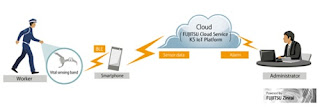Fujitsu
Estimates Workers’ Heat Stress Levels with New AI-Based Algorithm
Development
of algorithm contributes to strengthened summer safety in the workplace
Newswire) – Fujitsu Limited today announced the development of a new algorithm
to estimate ongoing heat stress in workers, such as security guards, using its
artificial intelligence technologies, known as Human Centric AI Zinrai.
Developed together with Fujitsu Laboratories Ltd., Fujitsu aims to enhance
solutions deployed on its digital business platform, “Fujitsu Digital
Business Platform MetaArc”(1), that use IoT to support on-site safety
management. This new algorithm will be available from the end of July. Also
from June through September, Fujitsu is implementing solutions incorporating
this new algorithm in a field trial with security guards at its own Kawasaki
Plant.
Previous algorithms estimated heat stress levels(2) using a
device worn on the arm to measure data such as humidity, temperature, as well
as increases in pulse, and were primarily used in manufacturing and at
construction sites. As the new algorithm can now estimate heat stress levels
that accumulate over time, it is suitable for employees who continually work
outdoors in the summer. Combined with the previous algorithm, it can be used to
manage safety in a wide variety of situations.
In order to estimate the level of accumulated heat stress,
and because a diverse range of data is handled in which correlations are
difficult to discern, the new system uses AI technology to execute machine
learning based on expert knowledge. In so doing, Fujitsu developed a logic in
which AI can extract the characteristics of high heat stress to enable
estimates such as those made by labor science experts.
In light of the knowledge gained from implementing this new
technology, Fujitsu is accelerating safety management support for customers
across a variety of industries. Fujitsu will help connect people, things and
infrastructure across boundaries between companies and industries through
“MetaArc” which will realize the customers’ digital transformation,
enhancing their competitiveness and creating new value.
Background
In recent years, the number of workplace casualties(3) due to
heat stroke in Japan has remained in the range of 400-500 people per year, even
after 2010, which saw the worst heat wave on record. In 2016, the number of
workplace casualties due to heat stroke reached about 450 people(4), leading
companies to take measures to prevent such incidents.
Going forward, the demand for heat stroke countermeasures is
expected to increase rapidly for security and other operations at outdoor
events and worksites in the summer.
Fujitsu developed this new AI-based algorithm to enhance
safety protection for employees working in extreme environments.
Features of the New Algorithm
In addition to the existing data of humidity, temperature and
pulse, the new algorithm estimates the level of heat stress based on new data,
such the amount of activity, as well as data that shifts over time.Since
machine learning is appropriate for making estimates from a wide variety of
data with unclear correlations, Fujitsu developed a logic in which AI can
extract the characteristics of high heat stress from the stock of actual data
and data evaluated by experts. This has enabled the algorithm to estimate
accumulated heat stress in the same way that labor science experts would,
enabling users to observe the status of individual employees in situations that
do not require a great deal of activity, such as security guards who must spend
long hours standing in the hot sun.
Summary of the Internal Field Trial
Fujitsu has applied its solution incorporating the new
algorithm to monitor those entering its Kawasaki Plant as well as security
guards on site. By conducting this internal trial from June through September,
months of extreme heat and humidity, Fujitsu is gaining the necessary knowledge
to eventually contribute to the safety of employees at customer facilities.
Sites where security and other duties typically take place
may be locations where workers are susceptible to heat stress. However, changes
in physical condition vary according to the individual, making it difficult to
take uniform measures. This newly developed algorithm makes it possible to
estimate the accumulation of heat stress on a per person basis, to tailor ways
to protect people based on individual conditions.
Image of the internal field trial
This solution will be exhibited at “Heat Solution Tokyo
2017,” to be held at Tokyo Big Sight, July 19-21.
(1) MetaArc
A digital business platform combining Fujitsu’s system
engineering knowledge and experience with cutting-edge technology, including
the cloud, mobile, analytics, IoT and AI.
(2) Heat stress level
The Japanese Society of Biometeorology calculates heat stress
levels from temperature, humidity and pulse, based on the relationship between
WBGT (Wet-Bulb Globe Temperature), air temperature and humidity. The heat
stress condition is estimated into four stages of safe, low, medium and high
heat stress.
(3) Number of casualties
Number of deaths and people who took four or more days off
work due to job-related illness.
(4) In 2016, there were approximately 450 casualties due to
heat stroke in the workplace
“Occurrences of Worker Fatalities Due to Heat
Stroke,” June 2017 report from the Ministry of Health, Labour and Welfare
in Japan. http://www.mhlw.go.jp
About Fujitsu Ltd
Fujitsu is the leading Japanese information and communication
technology (ICT) company, offering a full range of technology products,
solutions, and services. Approximately 155,000 Fujitsu people support customers
in more than 100 countries. We use our experience and the power of ICT to shape
the future of society with our customers. Fujitsu Limited (TSE: 6702) reported
consolidated revenues of 4.5 trillion yen (US$40 billion) for the fiscal year
ended March 31, 2017. For more information, please see http://www.fujitsu.com.
For the LATEST tech updates,
FOLLOW us on our Twitter
LIKE us on our FaceBook
SUBSCRIBE to us on our YouTube Channel!






